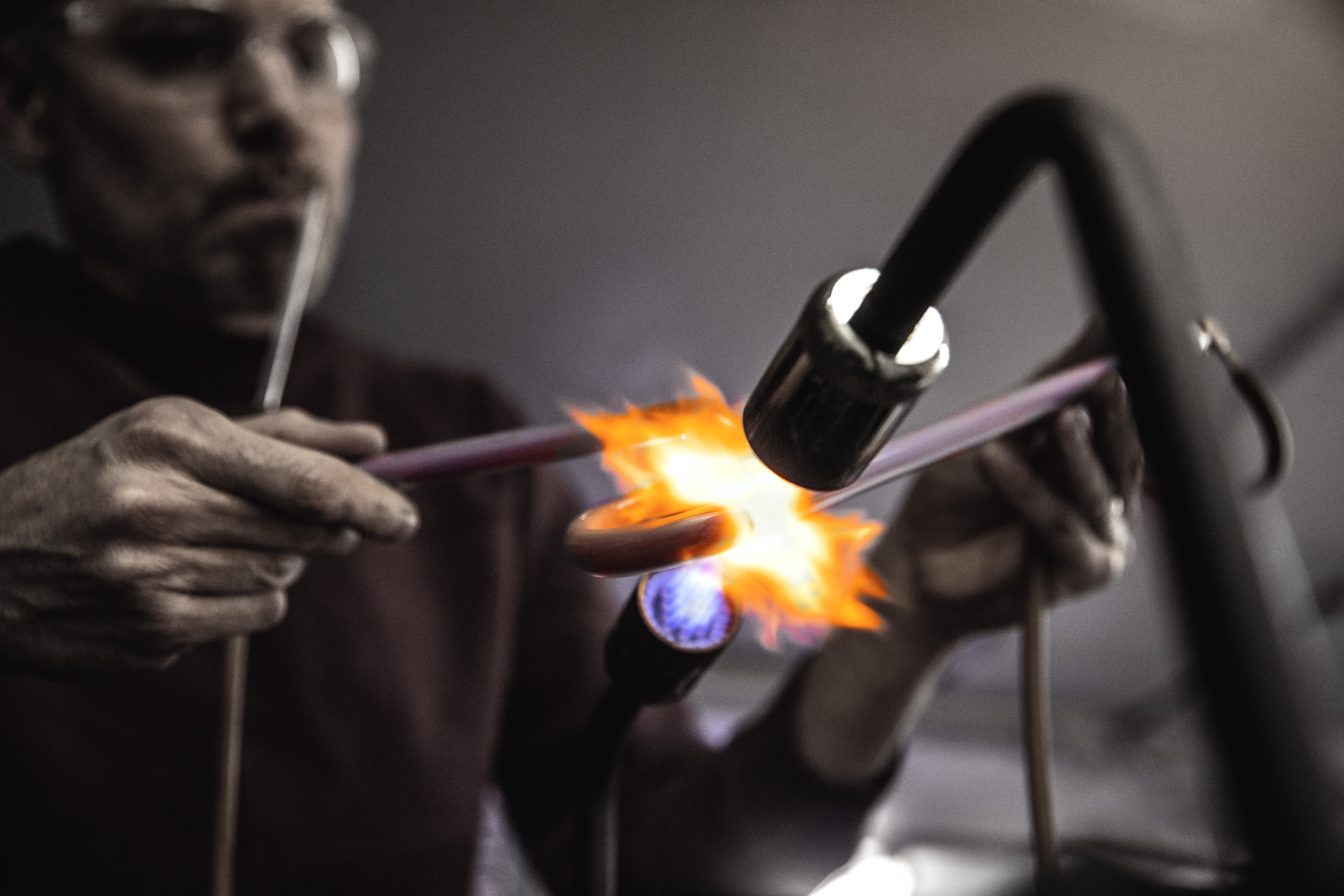
Neon Signs Are Glowing Strong in Seattle
On slick nights, a warm-white gloss envelops the intersection of East Union Street and 23rd Avenue. As chelsea rain boots thump toward nearby luxury apartments and buses barrel past, the reflection endures on the asphalt, defying the bustle on this gentrifying Central District block. The light’s source isn’t distinct from the neighborhood’s transformation. Outlined in faintly yellow neon tubing, identical signs that spell “Uncle Ike’s” have beamed from adjacent sides of this corner storefront for only a handful of years. But across a black facade, these three-foot cursive letters summon a bygone era, one when mom-and-pops could shine alongside the big boys. The argon-and-mercury script evokes a double-stroked signature that says, You can trust me. I’m family. In the shadow of apartment buildings guarded by keycards and punch codes, the message is stark in its invitation.
The twin signs also scream cannabis to locals. Ian “Uncle Ike” Eisenberg started his line of pot shops on this turf back in 2014. Uncle Ike’s was the second weed retailer to open in Seattle, a city by no means allergic to ganj but, in those days, still fighting through its first hit of the drug’s legalization. “Pot back then really had a stigma around it,” Eisenberg recalls of his store’s infancy, “and I thought something that blended in with the nostalgic fabric of the city might be more accepted by people that looked down on cannabis.”
To help mellow the traditionalists, Eisenberg turned to a scientific marvel that has illuminated some of Seattle’s most celebrated industries over the last century: neon signage. Conjured by electrifying noble gases trapped in glass tubing, neon lighting has long provided the city’s businesses with vibrant visuals. To craft his glowing letters, Eisenberg hired Western Neon, a Seattle firm largely responsible for neon’s continued presence here, well after technologies like LED have spurred its obsolescence elsewhere. For more than 35 years, Western Neon has fashioned signs for Seattle brands both hip and historic, from Filson to Pick-Quick Drive In to Fremont Brewing.
Seattleites, then, encounter Western Neon’s work during commutes, shopping sprees, binges. Our rapidly scaling tech firms may not proclaim their names in neon a la Pike Place Market vendors, but many of the new spots where their head counts play certainly do. Coders grab lunch at the Deck, the South Lake Union food court distinguished by a lighted arrow. They find fizzy refreshment below the neon bottle of Rachel’s Ginger Beer deep in Amazonia. They rest their heads at night in apartment complexes like Ava on Capitol Hill, where a radiant wrench hangs above a swanky common area. And, yes, they pick up Candy Kush beneath the sheen of Uncle Ike’s.
While its portfolio touts a bevy of businesses on the come up, Western Neon is also known for its restoration jobs. The company spent more than 500 hours refurbishing the beloved 7,500-pound, 16-foot Wonder Bread sign that stood atop its namesake’s Central District factory since 1952. When a 248-unit development replaced baking operations, the new owner paid to return the red neon sign to the building’s roof, appeasing grumbling neighbors. Most famously, the company re-created the Rainier “R” that overlooked I-5 from the top of the old Rainier Brewery for almost 50 years before its 2000 takedown—another project that fuses the city’s past and present.
“Neon is this medium that has this ability to be both nostalgic and futuristic at the same time,” says Dylan Neuwirth. Western Neon’s creative director, a Georgia native with a Southern manner and a fondness for flat-brim hats, belongs to the medium’s new school, a wave of innovators who marry neon’s artistic exploration to modern sign making and, in turn, keep it viable in the twenty-first century.
Viable doesn’t necessarily mean practical. Rachel’s Ginger Beer founder Rachel Marshall says her company’s neon signage adds “warmth to your storefront that a more traditional sign wouldn’t,” but the lighting at her newest bar in South Lake Union ran her about $30,000. That’s before the inevitable maintenance; a crack in the glass or a transformer snafu can leave you one glaring letter short. (Inadvertent profanity lurks, especially if your business has the word glass in its name.)
Yet, unlike in many cities around the country, neon’s shortcomings haven’t curtailed its popularity in Seattle. It isn’t as prevalent today as it was during the early- and mid-twentieth century, sure, but Western Neon’s ubiquity signals that contemporary business owners like Marshall and Eisenberg know now what business owners in old Seattle knew then: In this city, neon legitimizes.
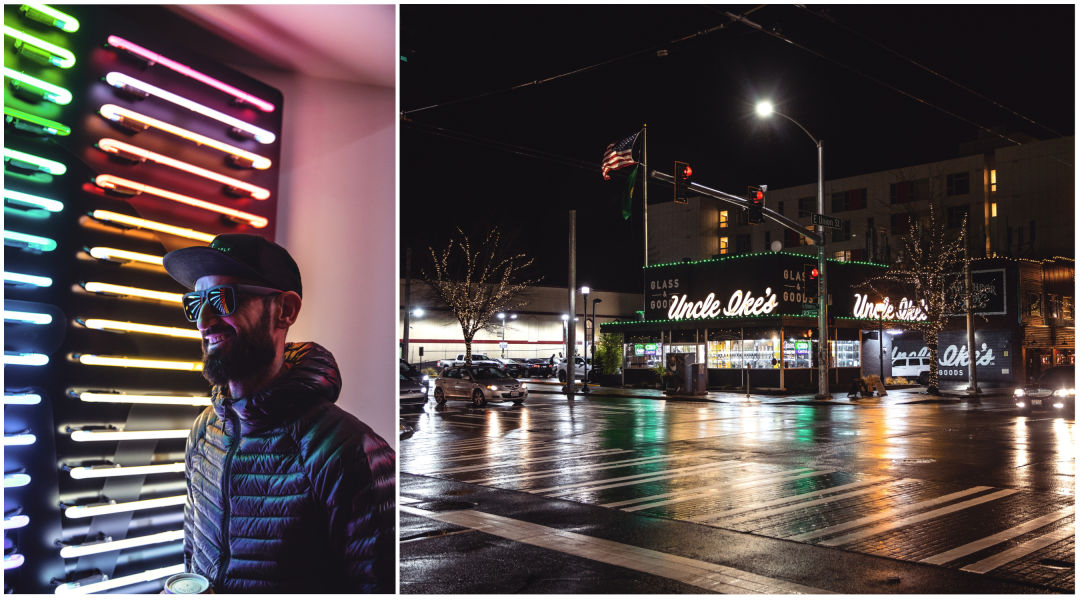
Western Neon creative director Dylan Neuwirth belongs to neon’s new school.
Image: Mike Kane
Lovers adult store is going through a rebrand, Neuwirth explains. Western Neon’s creative director stands across a workshop table from Will Kirtley, a kinetic glass bender in Saturday dad wear who eyes an illustration of the Washington-based company’s new sign prototype: a looping purple-and-pink “L”. In a bright basement room of the company’s SoDo space, alongside staffers who gas-inject, seal, and temperature-check tubes, Kirtley clutches a torch in one hand and draws its heat to where two glass pieces meet. As he waits for them to join, he keeps a mouthpiece tucked between his lips, blowing ever-so-softly through a cylinder to prevent the glass pieces before him from collapsing inward. The job requires some tricky maneuvers, like bending the tubes to hook like switchbacks on a mountain. But after more than 30 years of this work, Kirtley is adept enough at the techniques to teach them.
It wasn’t always that way. In the late 1980s, Kirtley convinced his grandmother that dropping out of DeVry University in Chicago to attend the Northern Wisconsin Neon Workshop was a sound investment. Back then, Dean Blazek’s six-week session in Antigo, Wisconsin, a farming town 90 minutes outside Green Bay, was one of the country’s only programs. A week into Blazek’s rigorous school, Kirtley was still struggling to make the difficult but oft-requested double-back bend. His instructor, a pragmatist about as cuddly as Walter Matthau, called him and a couple others into his office, informing them that they weren’t cut out for the work and that he would refund their tuition. Kirtley cried that night. The next day, though, he returned resolute. I’m not giving up on this, he told Blazek, who then urged him to stay. The teacher had just been testing him, instilling persistence. Later on, in Washington, as Kirtley bounced around different shops and worked out of his garage, he would need it.
But Kirtley would always have Blazek’s name to drop. That’s how he landed a gig here in the Northwest, at a company helmed by his instructor’s sons. Michael Blazek founded Western Neon in 1984, uprooting from Wisconsin to Washington to open the shop, initially located in Kirkland. Around 1990, his brother Jay took over, expanded the company’s client list, and added more types of signage. Both sons had been students of their father’s, learning the trade in a large warehouse surrounded by cornfields. The Wisconsin Sign Association had nudged Dean to start the program in the late 1970s, according to Michael, because most benders were nearing retirement age. By then the medium had been around for the better part of a century.
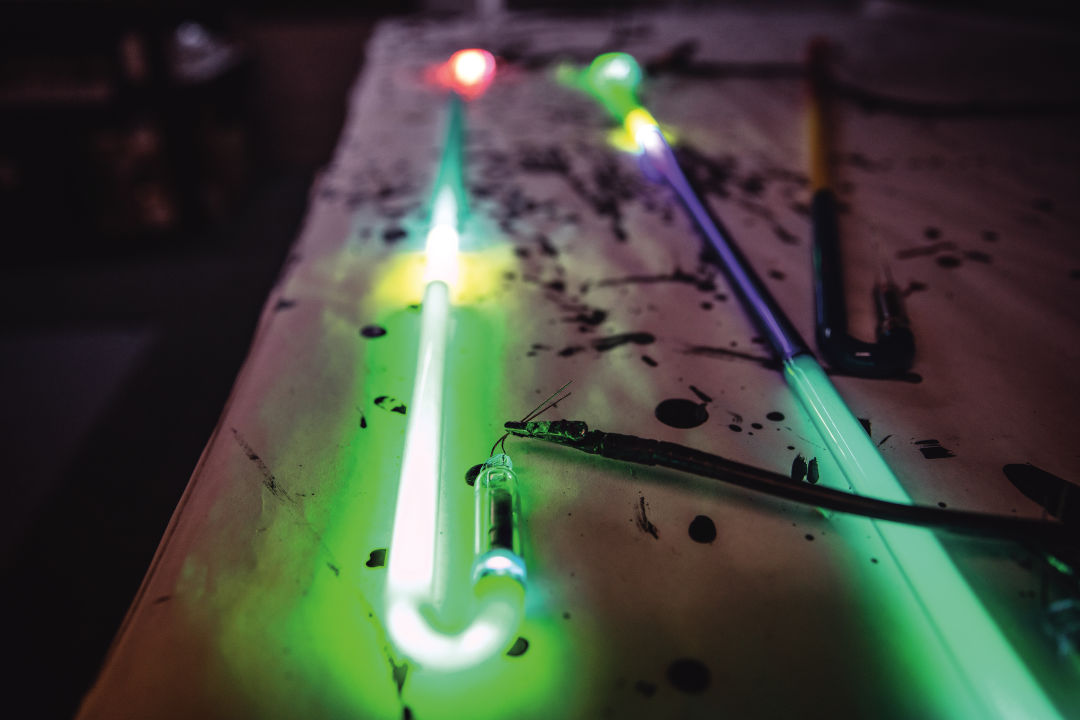
Electrified noble gases generate vibrant colors.
Image: Mike Kane
Early in June of 1898 two British scientists hunkered down in a lab at London’s University College, rushing to fill in the final empty spots of the periodic table. A week earlier, one of these men, Sir William Ramsay, had isolated krypton, which belongs to a group of colorless, odorless, tasteless, and mostly inert elements; today, we call them the noble gases. Presumably still feeling flush with discovery, the men experimented further with air liquefaction that afternoon until they unearthed neon. (The name stems from the Greek word for new.) Along with its noble brethren—argon, helium, krypton, and xenon—the gas became a source of neon lighting.
French engineer Georges Claude began sealing the gases in electrified tubing during the early 1900s. His neon lighting migrated from Europe to the U.S. en masse when a Packard car dealership in Los Angeles purchased two neon signs from Claude’s company in the mid-1920s. In 1927 Electrical Products Corporation of Washington formed. With its gray weather and robust port economy, Seattle quickly became a hub for “letters of fire,” as the Seattle Sunday Times called neon lighting. Local businesses trumpeted the city’s modernity through enormous gas-in-glass signage. In 1930 the Port Commission erected a 320-foot “Port of Seattle” neon sign on top of the Bell Street Terminal, beckoning sailors just as the Uncle Ike’s script draws cannabis connoisseurs today. “We were perfectly situated as a neon city,” says Leonard Garfield, the executive director of the Museum of History and Industry, which houses the original neon Rainier “R”.
Yet, as the twentieth century waned, a phenomenon once considered reputable became viewed by many Americans as garish and inconvenient. LEDs, with their long-lasting, energy-efficient glow, and other forms of lighting provided businesses with cheaper alternatives to handmade neon signs that demanded maintenance. The gas’s continued prominence in Las Vegas—Sin City—didn’t help neon shed its ties to night vices, either. A 1961 Seattle Sunday Times article advances this damning noir, noting that the war on crime transpired in “the neon glare of night spots, dark alleys and shabby hotel rooms.”
By the 1970s, neon signs had undoubtedly declined in Seattle. But they hadn’t gone completely dark.
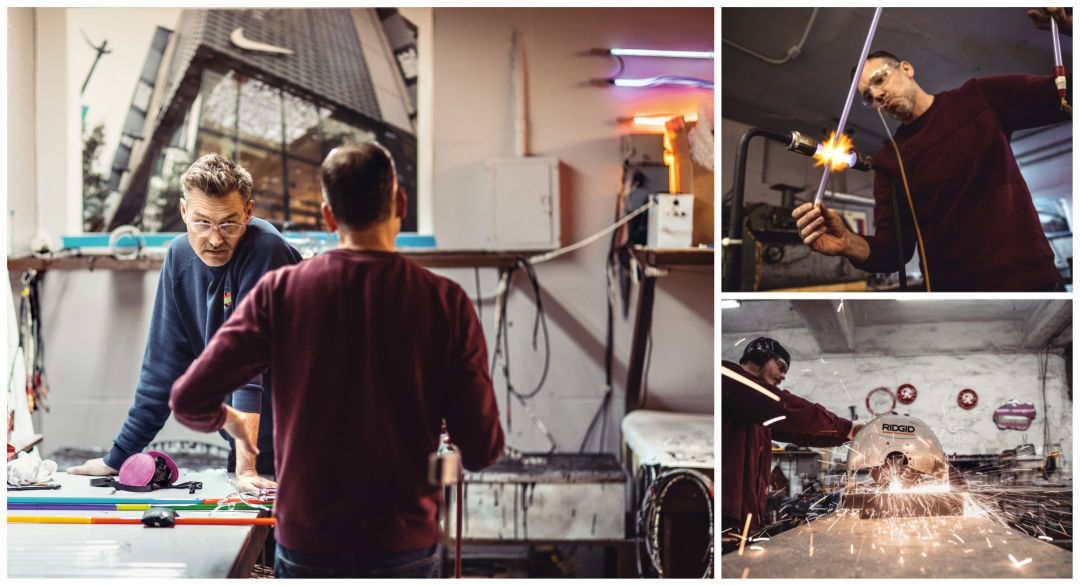
A basement workshop, aka neon tubing’s womb. Will Kirtley bends and welds glass. Glasses on.
Image: Mike Kane
Michael Blazek wasn’t sure his Chevy pickup’s suspension would survive the Rockies. He had just bought the truck to head west from Wisconsin to Washington. He planned to open a neon sign shop once he arrived, but an attached camper full of equipment—the ribbon burners, the torches, the bombarder transformer, the boxes of glass—was seriously weighing down those new wheels.
By September of 1984, when Michael’s father helped him load up his equipment for the cross-country drive, neon had experienced a bit of a revival. Artist Rudi Stern’s 1979 book, Let There Be Neon, reminded the world of the gas’s artistic potential. A college dropout in search of a trade, Michael took one of his father’s first classes around that time. Later on, a fellow student enticed Michael to venture to Seattle. The city had continued to cherish its iconic midcentury neon—the pink Elephant Car Wash sign, the Seattle Post-Intelligencer globe, and Pike Place Market’s array of radiant advertisements outside its shops.
When Michael arrived, Chevy intact, he was mostly subcontracting for other sign companies in Washington. Boosted by interest in Dale Chihuly, the state’s growing glass-art movement also helped sustain Western Neon—and Michael—financially and creatively.
In the mid-1980s, Michael showed work at a host of galleries in Seattle and elsewhere.
Western Neon was still a small business when its founder departed Seattle in 1990. After one particularly persuasive vacation in Australia, Michael decided to follow a colleague to Brisbane to help run a sign company there. He left Western Neon to his brother and former apprentice, Jay, a runner who never finished college. “My brother kind of took a gamble on me,” Jay says today.
It paid off. Over the next two-plus decades, Jay Blazek turned Western Neon into a fixture of Seattle’s commercial sign industry. (“He transformed the business,” is how Michael puts it.) Jay’s Western Neon made a range of different signs for customers, including LEDs. “Ninety-eight percent of the neon on the planet has disappeared in the last 15 years due to LEDs, largely,” Jay says. “I could see the writing on the wall.”
He also knew how to seize the spotlight.
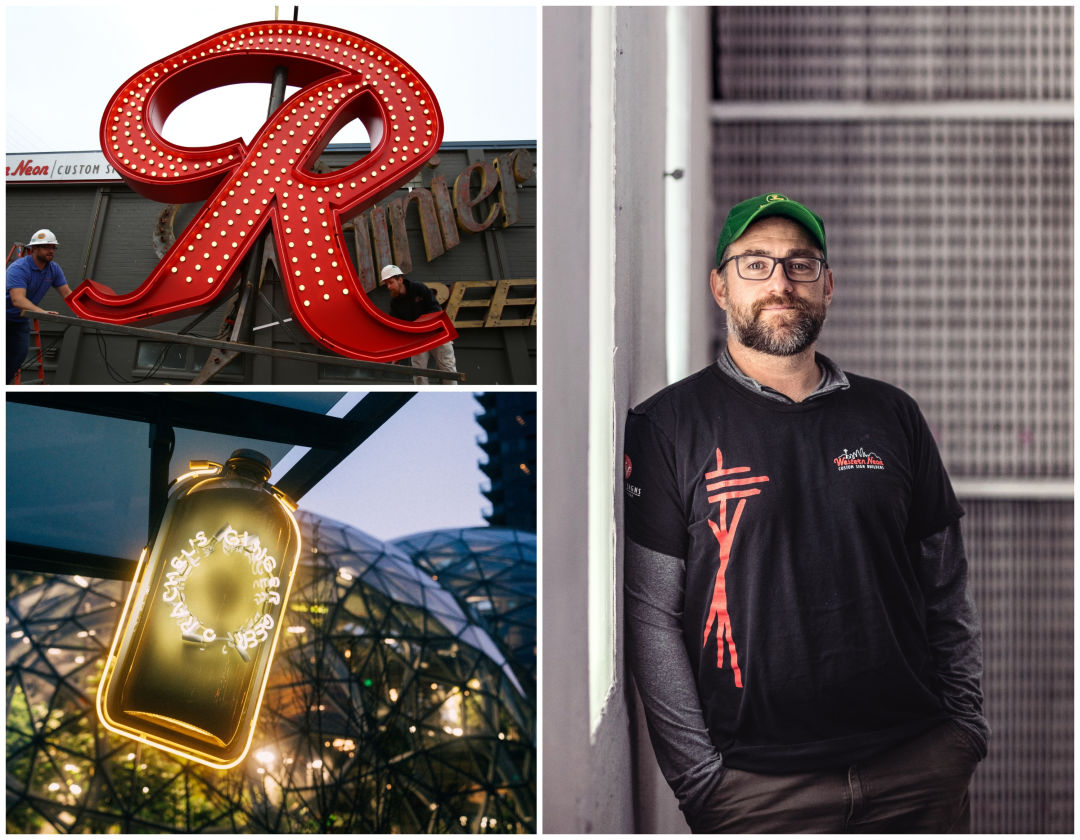
A replica Rainier “R” replaced the Tully’s “T” in 2013. Rachel’s Ginger Beer’s neon bottle in South Lake Union. André Lucero, Western Neon owner.
On July 4, 2000, a news crew posted up outside the old Rainier Brewery on Airport Way, covering a most unlikely changing of the guard. The iconic neon red Rainier “R” had stood atop the building for nearly half a century, but Tully’s Coffee, now operating a roastery in the structure, had hired Western Neon to replace the landmark with a neon green “T,” marking a new beverage’s reign in the city.
The spectacle almost didn’t happen. Jay Blazek had told Tully’s a sign of that magnitude required six to eight weeks of work. Three weeks before Independence Day, he got a call saying the installation would need to happen on the holiday—and it would be broadcast on the 10 o’clock news. Jay protested the tight deadline, but to no avail.
On the morning of arguably the most important day of his budding company’s history, the owner was bending and replacing the piece’s final tubes, hoping he would have everything done in time. Ultimately, the unseating went off smoothly. “I didn’t have to do a swan dive off the tower,” Jay quips now. While the televised event afforded Western Neon unprecedented publicity and a stream of new business, it was also a shining moment for neon itself. Michael Blazek could see that, even from thousands of miles away. “They knew if they put a big ‘T’ up there and lit it up on both sides,” he says of Tully’s, “everyone in Seattle would know they’re there.”
The eventual removal of the “T” also felt like a civic milestone. In 2013, Tully’s (chaired by none other than ex-Stormy Daniels attorney Michael Avenatti, who’s been in a litany of legal trouble himself) called upon Western Neon once again. The owners announced the company would swap in a replica of the Rainier “R” to honor the city’s history. By then, though, Jay Blazek was in New Zealand. He had burned “every possible calorie of energy” on the business and needed a life change and followed his brother to the Southern Hemisphere. But Jay wasn’t going to sell the company to just anybody. At a convention, he remembers, Rudi Stern once called the Blazeks “the first family of neon”—Jay had a reputation to uphold. He handpicked André Lucero, who swept floors as an apprentice before working his way up to a managerial position, as his successor. The new head of Western Neon also had other strengths—in particular, social media skills—that Jay lacked.
Under Lucero, the roughly 25-employee business broadened an already impressive range of clientele. Nonprofit and public sector projects now supplement its work with businesses. On the afternoon Will Kirtley was bending the Lovers prototype, staffers upstairs were assembling a Seattle Children’s Research Institute sign that read “Stopping Disease.” When light rail arrives in North Seattle next year, a re-creation of the giant Standard Radio sign will once again shine on the site of the new Roosevelt Station. And an upcoming public art project in Renton will demonstrate the company’s capabilities beyond neon, capturing the city’s industrial history in multiple forms.
Still, neon courses through the company’s veins, and cultivating an interest in the medium is at its heart. In 2017, Neuwirth, Lucero, and technical director Kelsey Fernkopf started a nonprofit that offers introductory and intermediate classes in bending and illuminating glass. At the Western Neon School of Art, students can practice some of the same techniques that Will Kirtley struggled to grasp at Dean Blazek’s workshop all those years ago. The programs at the Seattle firm’s headquarters aren’t supposed to spit out Kirtleys, mind you. “We’re not training sign makers here,” Neuwirth says. Students learn the bending basics, sure, but their focus is on “art that works,” as a sign above the school’s eight workstations says. They examine the intersections of light, space, and technology, the mix that makes neon timeless to enthusiasts, including a budding pot emperor.
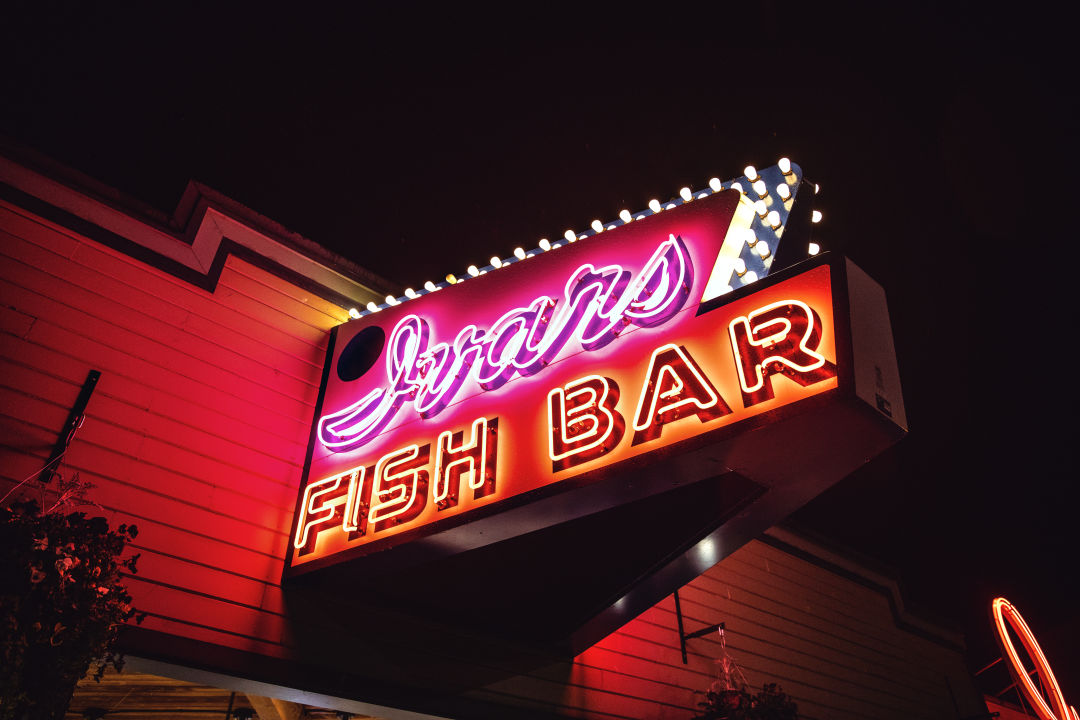
Two Seattle institutions: The Ivar's sign inspired the one at Uncle Ike's, the second weed retailer to open in the city.
Image: Mike Kane
Long before he owned Uncle Ike’s, Ian Eisenberg appreciated neon signs as a meeting of art and science, the sculpture of the glass tubing’s fabrication coupled with the infusion of gas inside. The neon at Ivar’s Acres of Clams drew plenty of his admiration. Growing up in Madrona, Eisenberg, like everyone else in the city, knew the seafood restaurant, which meant he knew of Ivar Haglund. The “King of the Waterfront” opened Seattle’s first aquarium on Pier 54 in 1938, shamelessly promoting his undertaking by, among other stunts, pushing a seal through Pike Place Market en route to a Santa photo op and arranging a wrestling match between an octopus and a prizefighter. In 1946 he opened Ivar’s Acres of Clams, a formal realization of a fleeting fish-and-chips business he had launched to accompany the aquarium. Ivar’s was a hit in no small part due to the proprietor’s sense of humor. Foremost among Haglund’s promotional puns was “keep clam,” an eye-roller or knee-slapper depending on your taste but, like it or not, one that persists today in local parlance.
Eisenberg admired how Haglund’s personality and his business were inextricably tied to one another, and his nascent cannabis empire’s marketing tactics bear some resemblance to Haglund’s not-so-subtle quips. (The phone number for Uncle Ike’s is 1-800-GET-DRUGS.) With his business’s glowing script, Eisenberg also wanted to mirror Haglund, whose cursive Ivar’s signage represented the neon aesthetic of waterfront businesses of that time. The two signatures aren’t identical—the “I” in Uncle Ike’s lacks the Ivar’s flourish—but they both convey the same ownership, the same warmth. It’s a measurable quality. Upon finishing his first work on Uncle Ike’s signage, Will Kirtley recalls fixating on its color: an almost-yellow white measuring 3,000 kelvin on the color-temperature spectrum, about as warm as it gets. “It is a very unusual white,” he says.
That warmth can spread. On a recent trip back to Seattle from Australia, Michael Blazek walked around Pioneer Square and other neighborhoods. Along the way, the Western Neon founder snapped photographs of neon signs shining throughout the city he left decades ago. Though Seattle’s dark skies lend themselves to this time-tested medium, the city’s climate has a less obvious benefit: wetness. Soaked streets and sidewalks reflect the light. It spreads across surfaces, businesses, and neighborhoods, new and old, coating cobblestones and concrete in orange or pink or emerald, defeating the city’s gloom.




